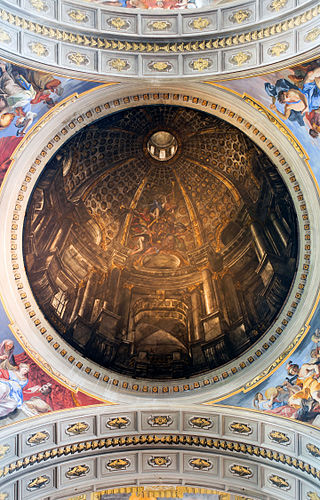
Illusionistic ceiling painting, which includes the techniques of perspective di sotto in sù and quadratura, is the tradition in Renaissance, Baroque and Rococo art in which trompe-l'œil, perspective tools such as foreshortening, and other spatial effects are used to create the illusion of three-dimensional space on an otherwise two-dimensional or mostly flat ceiling surface above the viewer. It is frequently used to create the illusion of an open sky, such as with the oculus in Andrea Mantegna's Camera degli Sposi, or the illusion of an architectural space such as the cupola, one of Andrea Pozzo's frescoes in Sant'Ignazio, Rome. Illusionistic ceiling painting belongs to the general class of illusionism in art, designed to create accurate representations of reality.

The Palazzina di caccia of Stupinigi is one of the Residences of the Royal House of Savoy in the Metropolitan City of Turin in northern Italy, part of the UNESCO World Heritage Sites list. Built as a royal hunting lodge in the early 18th century, it is located in Stupinigi, a suburb of the town of Nichelino, 10 km (6 mi) southwest of Turin.

San Martino ai Monti, officially known as Santi Silvestro e Martino ai Monti, is a minor basilica in Rome, Italy, in the Rione Monti neighbourhood. It is located near the edge of the Parco del Colle Oppio, near the corner of Via Equizia and Viale del Monte Oppio, about five to six blocks south of Santa Maria Maggiore.
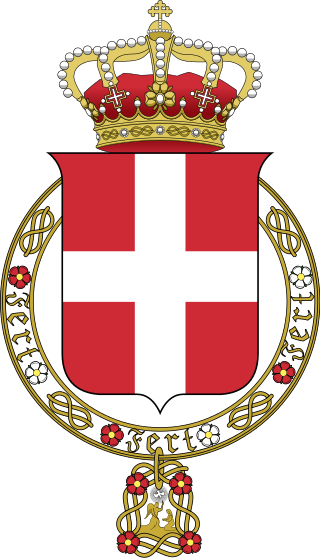
The Residences of the Royal House of Savoy are a group of buildings in Turin and the Metropolitan City of Turin, in Piedmont. It was added to the UNESCO World Heritage Sites list in 1997.
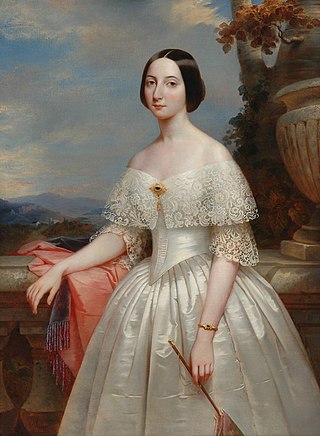
Adelaide of Austria was Queen of Sardinia by marriage to Victor Emmanuel II of Sardinia, future King of Italy, from 1849 until 1855 when she died as a result of gastroenteritis. She was the mother of Umberto I of Italy.

Nichelino is a comune (municipality) in the Metropolitan City of Turin in the Italian region of Piedmont, located about 8 kilometres southwest of Turin.

Vinovo is a comune (municipality) in the Metropolitan City of Turin in the Italian region Piedmont, located about 14 kilometres (9 mi) southwest of Turin.
Stupinigi is a frazione (hamlet/borough) of the comune (municipality) of Nichelino, in the Metropolitan City of Turin. It has a population of about 200. It borders the comuni of Candiolo and Orbassano on the southwestern outskirts of Turin, about 10 km from the centre of the city. Before 1869, it formed part of the comune of Vinovo.

The Basilica of Superga is a hilltop Catholic basilica in Superga, in the vicinity of Turin, Italy.

The Royal Palace of Turin is a historic palace of the House of Savoy in the city of Turin in Northern Italy. It was originally built in the 16th century and was later modernized by Christine Marie of France (1606–1663) in the 17th century, with designs by the Baroque architect Filippo Juvarra. The palace also includes the Palazzo Chiablese and the Chapel of the Holy Shroud, the latter of which was built to house the famous Shroud of Turin.

Giuseppe Nogari was an Italian painter of the Rococo. He painted mainly painted half-body portraits, either real or of historical and religious figures. They are striking for their emotional content, subdued decoration and coloration, and often display aged individuals in somewhat homely or shabby attire with a dark background.

Italy has a very broad and diverse architectural style, which cannot be simply classified by period or region, due to Italy's division into various small states until 1861. This has created a highly diverse and eclectic range in architectural designs. Italy is known for its considerable architectural achievements, such as the construction of aqueducts, temples and similar structures during ancient Rome, the founding of the Renaissance architectural movement in the late-14th to 16th century, and being the homeland of Palladianism, a style of construction which inspired movements such as that of Neoclassical architecture, and influenced the designs which noblemen built their country houses all over the world, notably in the United Kingdom, Australia and the United States of America during the late-17th to early 20th centuries.
Giacomo Benevelli was an Italian and French sculptor. He was brought up in France. He lived and studied in Nice, Paris, Rome, Aix-en-Provence, Munich. He mainly lived and worked for over forty years in Milan.

The Palace of Venaria is a former royal residence and gardens located in Venaria Reale, near the city of Turin in the Piedmont region in northern Italy. It is one of the 14 Residences of the Royal House of Savoy built in the area between the 16th and 18th centuries which were collectively designated a UNESCO World Heritage Site in 1997.

North-Western Italian architecture refers to architecture in the North-Western regions of Italy, and their capital cities.
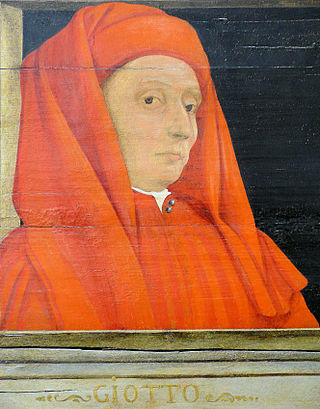
Giotto di Bondone, known mononymously as Giotto and Latinised as Giottus, was an Italian painter and architect from Florence during the Late Middle Ages. He worked during the Gothic and Proto-Renaissance period. Giotto's contemporary, the banker and chronicler Giovanni Villani, wrote that Giotto was "the most sovereign master of painting in his time, who drew all his figures and their postures according to nature" and of his publicly recognized "talent and excellence". Giorgio Vasari described Giotto as making a decisive break from the prevalent Byzantine style and as initiating "the great art of painting as we know it today, introducing the technique of drawing accurately from life, which had been neglected for more than two hundred years".

Benedetto Innocenzo Alfieri was an Italian architect, a representative of the late-Baroque or Rococo style.
Gerolamo Mengozzi Colonna was an Italian painter, mostly of frescoed quadratura.
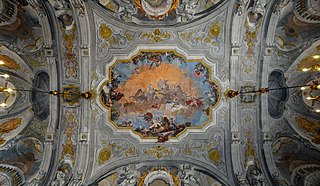
Giovanni Battista Crosato was an Italian painter of quadratura, active in the 18th century in Piedmont.
The denominazione comunale d'origine (De.CO) or denominazione comunale (De.Co.) is an Italian recognition established and granted by the municipal administration in order to protect and enhance a typical product, a traditional recipe, an agri-food business or a craft product in close correlation with the territory and its community, without any overlap with the designations of origin in force. The municipal designation of origin, unlike designations such as PDO, PGI and TSG, is not a quality indication, but a certificate of typicality.















